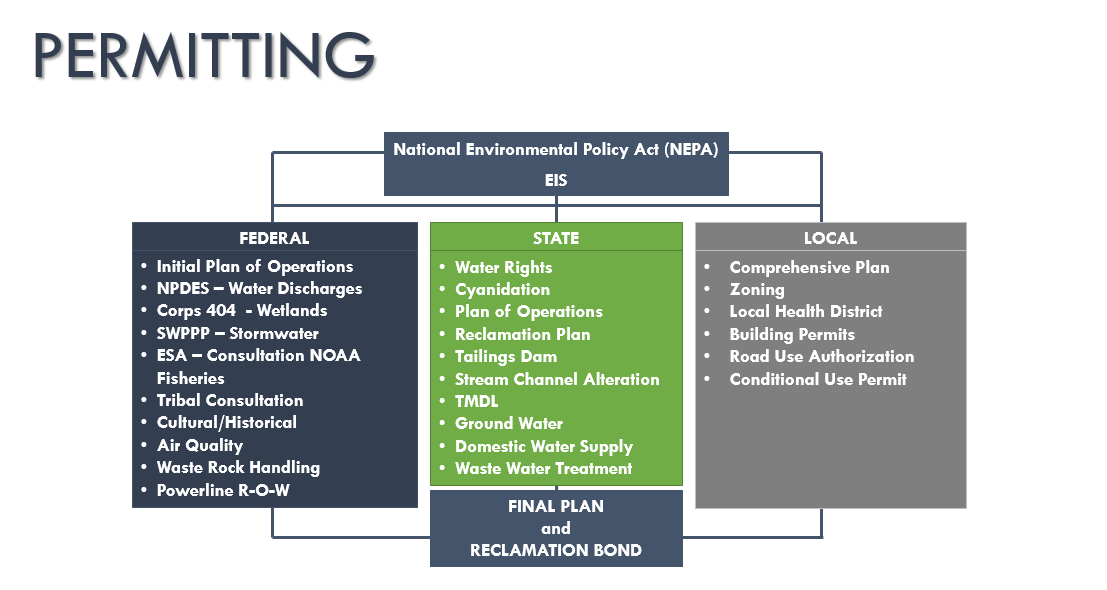Published on November 16, 2018
Midas Gold Idaho wants to keep the community informed about the work we are doing at the Stibnite Gold Project site. The Ask Midas blog series gives the experts in our company a chance to answer some of the community’s most frequently asked questions and help clear up any misconceptions around the project.
Mine companies in the U.S. are held to some of the strictest permitting requirements in the world. Before our project can begin, Midas Gold will have to obtain more than 50 permits from federal, state and local regulatory entities relating to air and water quality, fisheries, wildlife and cultural resources. Applications for each of these permits requires a rigorous process of data collection and analysis to demonstrate that we will operate within the bounds of applicable laws, rules and regulations. In addition to these permits, Midas Gold’s proposed Stibnite Gold Project occurs, in part, on public land and therefore is subject to a thorough and comprehensive environmental impact analysis and decision-making process under the National Environmental Policy Act (NEPA).
In this week’s Ask Midas blog, I am going to walk you through this process step by step so that you can understand how the permitting process works and how to get involved.
HOW DO THE NEPA AND MINE PERMITTING PROCESSES WORK?
In addition to rigorous environmental permitting, any project that takes place on public land must go through an environmental review process under NEPA, regardless of whether it’s a mining project or building a new ski hill. This process is designed to make federal agencies consider the environmental, social and economic impacts of proposed projects. It also requires them to consider alternatives to the proposed project that may reduce the environmental impacts. Community members have an opportunity to be involved in the decision-making process by providing comments about the project and offering up their thoughts on potential alternatives.
A good summary of the relationship between NEPA and environmental permitting processes is included in our Plan of Restoration and Operations (PRO). As we note in the PRO, Section ES.21:
The preparation of an environmental impact statement and the permitting processes are related but distinctly separate. An environmental impact statement is a procedural tool designed to explore alternatives and discuss environmental impacts. The permitting or approval processes give individual government decision makers the authority to grant, conditionally grant, or deny individual permit applications. Permits may be granted with requirements and conditions to eliminate and/or mitigate specific adverse impacts, or to conduct monitoring, pursuant to their governing statutes, regulations and guidelines.
Here is how the process works under NEPA and what that has looked like for the Stibnite Gold Project.
Step 1: Federal Agency Submits a Notice of Intent to Prepare an Environmental Impact Statement
If a project is proposed on federally-managed public land, the lead federal agency conducts an initial review to determine whether it will have a significant impact on the environment. Based on that review, a decision is then made as to whether the subsequent environmental analysis will include preparation of a categorical exclusion (for little to no anticipated impacts), an environmental assessment (for moderate but not significant impacts) or an environmental impact statement (EIS) (for significant environmental impacts). For the Stibnite Gold Project, the U.S. Forest Service (USFS), which is the lead agency on the project, has determined the most rigorous level of analysis is appropriate and an EIS will be prepared.
The NEPA process kicks off when an agency submits a notice of intent (NOI) to prepare an EIS. The NOI must be published in the Federal Register and give citizens information on the proposed project, its potential impacts, the outlined plan and how people can get involved in the identification of significant issues and the review of prepared analysis documents. Midas Gold’s NOI was published on June 5, 2017.
Step 2: Agency and Public Scoping
An initial step in the preparation of an EIS includes agency scoping (an internal process), followed by an opportunity for the public to provide comments on the proposed project. During the public scoping process, individuals and organizations can submit public comments and provide recommendations to the lead agency about the project. Scoping offers an opportunity for the public to identify important issues that need to be addressed in the EIS, and to provide input on possible reasonable alternatives to the proposed action.
Public scoping can have a huge impact on the outcomes of projects. For the Stibnite Gold Project, one issue raised during public scoping was the importance of maintaining access through our site for recreationalists during construction and operations. Originally, we did not plan to have a public access route through the site, primarily because of safety concerns. However, during scoping, we quickly realized this was an important issue for the community, and our team worked together to identify a potential solution that still prioritized safety. As a result, additional alternatives for public access have now been incorporated into the range of possible project alternatives to be considered in the EIS.
Step 3: Prepare a Draft Environmental Impact Statement
We are currently waiting for our draft EIS (DEIS) to be completed by the USFS and released for public comment. The DEIS is meant to clearly communicate the purpose and need of a project, from the perspective of the lead agency, and identifies a range of alternatives to the proposed action that meet the identified needs of the project.
In September of 2016, after years of collecting baseline studies and immense amounts of data, Midas Gold submitted our Plan of Restoration and Operations (PRO) to the U.S. Forest Service for Review. The PRO outlines what we believe is the best way to mine the area and restore the site. Consistent with their obligations under NEPA, the USFS and their cooperating federal, state and local regulatory agencies are now evaluating that plan, identifying and evaluating alternatives to it, and assessing the environmental impact of our plan and a range of potentially feasible alternatives. Through this process, they will identify a preferred combination of alternatives that they feel meets the purpose and need of the project and minimizes environmental impacts to the degree practical. Therefore, when Forest Service officials release their DEIS, we expect it may include different options for some elements of our project. NEPA requires federal agencies to evaluate all reasonable alternatives (particularly from an environmental, but also a technical and economic standpoint) for a project. They must do this in order to thoroughly review and consider a range of options and potential environmental impacts.
Step 4: Public Comment on the draft EIS
As soon as the USFS releases the DEIS, they will invite the public to comment on it. We expect the DEIS to be released and the public comment period to begin in mid-2019.
When an agency releases a DEIS, community members typically have 45-days to submit their comments. While comments are not a vote on whether or not a project should move forward or not as proposed, they can help to influence decisionmakers. It is important that comments on the DEIS speak specifically to aspects of the proposed project, and not just to personal opinions. Substantive comments, as they are called, are unique, provide a basis to question the accuracy of information, or put forth new information that can be valuable for further analysis of the plan.
For our project, we have prioritized locating facilities on previously disturbed areas to maximize opportunities for incorporating environmental cleanup and habitat restoration into our mining processes. Some of the alternatives evaluated in the DEIS may reduce the restoration potential of our project. If restoring the site is important to you, during the public comment period, write to the USFS and tell them to prioritize the approach to restoration that Midas Gold has proposed in the PRO.
Step 5: Final EIS is Released
As soon as the public comment period ends for the DEIS on the Stibnite Gold Project, the USFS will go back and analyze the comments they received and conduct any additional analysis needed to prepare the final EIS. The final EIS must address all substantive comments received during the comment period.
Responses to comments can vary widely. In some cases, the USFS may determine changes are needed to the plan. In other instances, they may just correct some factual information or refer the reader to additional information already included in the document to provide clarification. In either case, public comments prompt rigorous review of the DEIS and are an important part of the NEPA process.
The Final EIS on the Stibnite Gold Project must be released for at least 30-days before any decisions can be made about the future of our project.
Step 6: Record of Decision (ROD)
After all the steps above are completed, an immense amount of data has been evaluated and the public has weighed in, the lead federal agency will publish their Record of Decision (ROD). The ROD documents the process, outlines their final decision on the project, the prescribed path forward and the mitigation plans and monitoring requirements companies will need to meet. It also revisits the proposed alternatives considered throughout the permitting process so community members can understand all the options that were weighed in making the final decision.
The ROD will give us the blueprint we will follow for the life of the Stibnite Gold Project. Once it is released, the community will know exactly how we will be required to mine the site, the restoration and reclamation work we are required to complete.
We anticipate a ROD on the Stibnite Gold Project will be released in 2020.
Step 7: Financial Assurance
Once the ROD is issued, the agencies will determine how much money we will need to set aside in bonding to complete the important reclamation and restoration work of the site. At Midas Gold, we have committed to following a higher standard for determining reclamation costs. Instead of setting aside the required flat fee per acre, we will take the ROD, look at all of the outlined activities, and determine how much it would actually cost an independent, third-party contractor to come in and complete restoration work. It is important to note, before the project can officially start, and even one shovel of dirt can be moved, we must post all the reclamation bonds.
Step 8: Permits
The ROD to begin mining is not the end of working with federal, state or local agencies. We still are required to obtain over 50 permits for various aspects of our operations. It is likely that the applications and processing of many of these permits will precede the ROD. However, final permits may not be received until the release of the ROD. These permits provide additional checks and balances to make sure we have the right plans in place to ensure the project is done right. The graphic to the left provides you a snapshot of all of our different permits. In accordance with the ROD and some of our permits, we will need to report to regulators throughout the life of our project to ensure we are following through on our commitments and implementing the ROD exactly as it is outlined. If we ever wanted to make any substantive changes to our project, we would need to go through the entire process again, beginning with submittal of a modified plan of operations and proceeding through NEPA.
If you have further questions about permitting and the Stibnite Gold Project, I encourage you to come and visit with our staff during our monthly office hours in Donnelly. The second Friday of each month from 11 a.m. to 3 p.m. our team is available to answer your questions and help you learn more about Midas Gold and our plans for the future.

